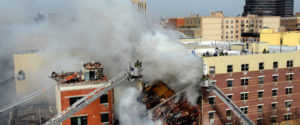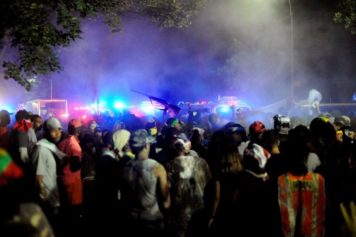
Shortly after an East Harlem resident complained to the Con Edison utility company about the odor of gas, an explosion shook the neighborhood at about 9:30 a.m. on Wednesday.
The resulting scene, according to Robert Sumwalt, a member of the National Transportation Safety Board, which reviews accidents involving natural gas, was “in one word, devastating.”
“You’ve got basically two five-story buildings that have been reduced to essentially a three-story pile of bricks and twisted metal,” he said. “The smell of smoke is omnipresent.”
As of this morning, only four victims’ identities have been released: Griselde Camacho, 44, a public safety officer for Hunter College in East Harlem; Carmen Tanco, 67, a dental hygienist; Rosaura Hernandez, 21, and Andreas Panagopoulos, 43.
New York City police said five people are still missing. Of the more than 60 injuries, at least three children were hurt; two were treated for minor injuries and released, while a third was in critical condition, hospital officials said.
Officials said 40 percent to 50 percent of the debris had been removed by Thursday evening, but a fire was still burning and the force of the explosion had collapsed and pancaked layers of floors. The back wall that was still freestanding posed a collapse hazard. Workers hoped to remove debris at the site on Friday and make it down to the first floor by Saturday, then move to the basement.
At the center of the ruins was the 80-year-old Spanish Christian Church, which was located on the ground floor at 1644 Park Avenue but residents said it actually took up the whole building, with the upper rooms set aside for members of the congregation and the indigent.
Next door to the church was Absolute Piano at 1646 Park, above which lived a piano technician specializing in dampers, a piano mover and three piano finishers.
There were dozens left homeless from the two buildings and a neighboring one that suffered damage. Many residents were being housed at a shelter on 125th Street.
Altogether, the two buildings housed 15 apartments, in addition to the church and piano store.
According to published reports, residents of seven nearby buildings, with nearly 90 apartments, lost heating and gas services.
“Anyone affected by this tragedy will be helped – anyone – regardless of immigration status. … They should not be afraid,” Mayor Bill de Blasio said.
The mayor said he wished the neighbor who called Con Ed on Wednesday morning had called the night before, when he first noticed the gas odor.
“That might have given us an opportunity here,” said de Blasio, who urged anyone who smells gas to immediately call Con Edison or the city’s complaint line at 311.
The incident raised once again the danger in the aging gas pipes that run underneath many of the nation’s older cities. Many of them are made of cast iron, which is much more susceptible to leaks than a more pliable material like plastic. In addition to becoming more brittle over time, heavy blows can crack the pipes, as can ground movements caused by alternating spells of warmth and cold.
According to federal data published on the Huffington Post, serious leaks causing death, injury or major property damage stem from cast-iron pipes four times more often than those made from other materials. There was a leak in a cast-iron gas pipeline in Philadelphia in January 2011 that led to an explosive blast that killed a utility worker and injured five others. Just a month later, a leaky cast-iron gas main caused a major explosion in Allentown, Pa., killing five people, including a 16-year-old girl and a 4-month-old boy.
According to the Huffington Post, federal data from 2012 reveals that nearly a third of the gas lines in Washington, D.C., and Boston are made of cast iron, and nearly half of Philadelphia’s lines are made of the antiquated material.
“Whenever the infrastructure went in, people used what they had at the time,” said Brigham McCown, a consultant and former administrator of the U.S. Pipeline and Hazardous Materials Safety Administration. “By and large in most American cities, that’s a cast iron-type product. It becomes brittle, it becomes harder, and it’s more difficult to get a seal.”
Ironically, the Center for an Urban Future, a New York City public policy group, released a 66-page report a day before the East Harlem explosion, detailing an extensive list of problems plaguing the city’s aging infrastructure—particularly the prevalence of cast iron distribution lines for natural gas.


